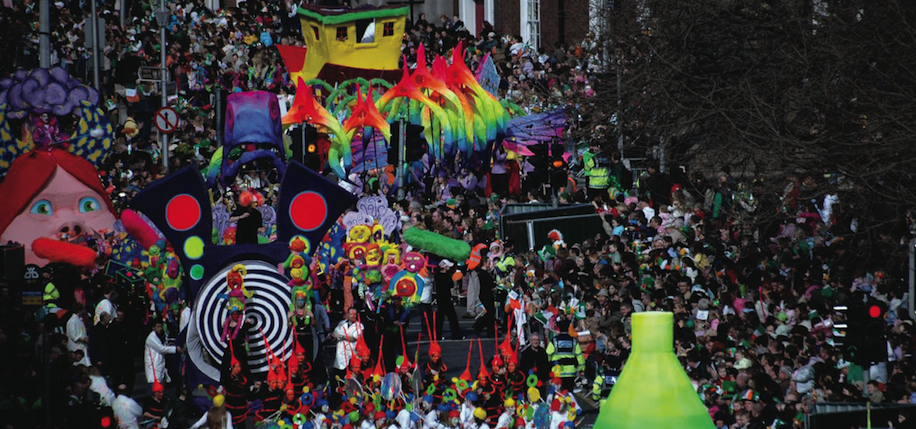Maeve Binchey, the renowned Irish author, explains how St. Patrick’s Day has changed in Ireland.
St. Patrick’s Day used to be the dullest day in the Irish calendar until we got sense and learned to follow our transatlantic brethren and make it into a carnival.
When I was young in the 1950s, March 17 was a bit like Tombstone City. For one thing it was in the middle of Lent and there was always a huge argument at school about whether the saint was important enough to warrant a day off from the merciless self-denial we all practiced then.
Was it perhaps a matter of honoring him greatly by getting stuck into bars of chocolate in his name? Or was it only a cheap back door to getting more carbohydrates?
Then, even though it was a day off school, it was mainly a heavily religious day.
After Mass where we all sang “Dochas Linn,” “Naomh Padraig,” “Aspal Mor na hEirinn” and “Hail Glorious St. Patrick,” we used to go on two bus journeys across the city and see my aunt who was a nun in a convent in Drumcondra. Sometimes we saw the hint of a horrifically bad Industrial Parade, which had tractors and awful things in it, and honestly you were better off not seeing it at all. There used to be people frozen to death watching it go by the General Post Office and my mother would say, “Isn’t it the mercy of God that your father doesn’t have a high civil service job or he would have had pneumonia by lunchtime.”
And all over Ireland every single public house was closed.
Yes, that’s true. Three days a year – Good Friday, Christmas Day and March 17 – the hostelries had to close their doors.
Now I suppose if you knew the right people you could sneak in a back door. But back then girls didn’t really GO to pubs. They were male places smelling of porter, with males smoking heavily, consulting the racing pages and debating politics.
Nice girls had no place there. Or so we were told.
But with the sixties came some rays of light. Women began to realize that they had every right to be everywhere.
And we wanted improvements too. Nice Ladies Rooms, ice in our drinks, and carpets on the floor. Our generation changed the face of the pubs and bars you all know so well. We are responsible for the kind of places they are now.
But one thing we couldn’t change. The pubs still stayed closed on St. Patrick’s Day. It seemed as if this was going to last until the End of the World.
There are of course ways around everything. A small Dublin dog show, which might have expected a trickle of supporters to come and watch the Best of Breed being judged, became instead a magnet for thousands in Ballsbridge.
The show had a dispensation or an exemption or whatever they called it, and therefore was the only place in the capital city where you could get alcohol.
On the national holiday, Myles na gCopaleen (Flann O’ Brien) in his witty Irish Times column complained that there was a very irritating sound of hounds barking when he went for his Patrick’s Day pint at the Dog Show. It seemed to him to be an odd kind of place to bring a dog. But then like a rumble on the horizon came the television footage of the celebrations in cities all over the United States.
Marshals and Grand Marshals, drummers, cheerleaders, the Department of Corrections marching with shamrocks in their helmets, the Mother Cabrini High School Band dancing up and down the great avenues, pipers with different tartans, old and young marching, and hundreds and thousands of spectators cheering them on.
Hey, wait a minute. Wasn’t this meant to be OUR show? Didn’t St Patrick come here, here to Ireland, not to Manhattan and Chicago? The discontent and envy and sheer jealousy made itself felt and now we have a party too.
The Dog Show is back to normal proportions again, and we are no longer ashamed of the poor show we put on in the saint’s honor for decades in the past. Often when I was in New York wandering around on St Patrick’s Day astounded and envious of all I saw, I would meet Irish men and women in bars on Third Avenue. They would tell me that one day before they died they would come back and march in a proper parade in their homeland.
I used to pray silently that they never would make the journey – I couldn’t bear to think of such disillusion. But now it’s safe.
They CAN come back to Ireland.
They will see a whole week of festivity and their native land having its rightful carnival.
And somewhere up there in his Mansions Above, St. Patrick is feeling a lot better about it too.
Maeve Binchey’s latest book, Whitethorn Woods, is currently in bookstores. ♦


Leave a Reply